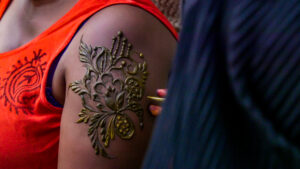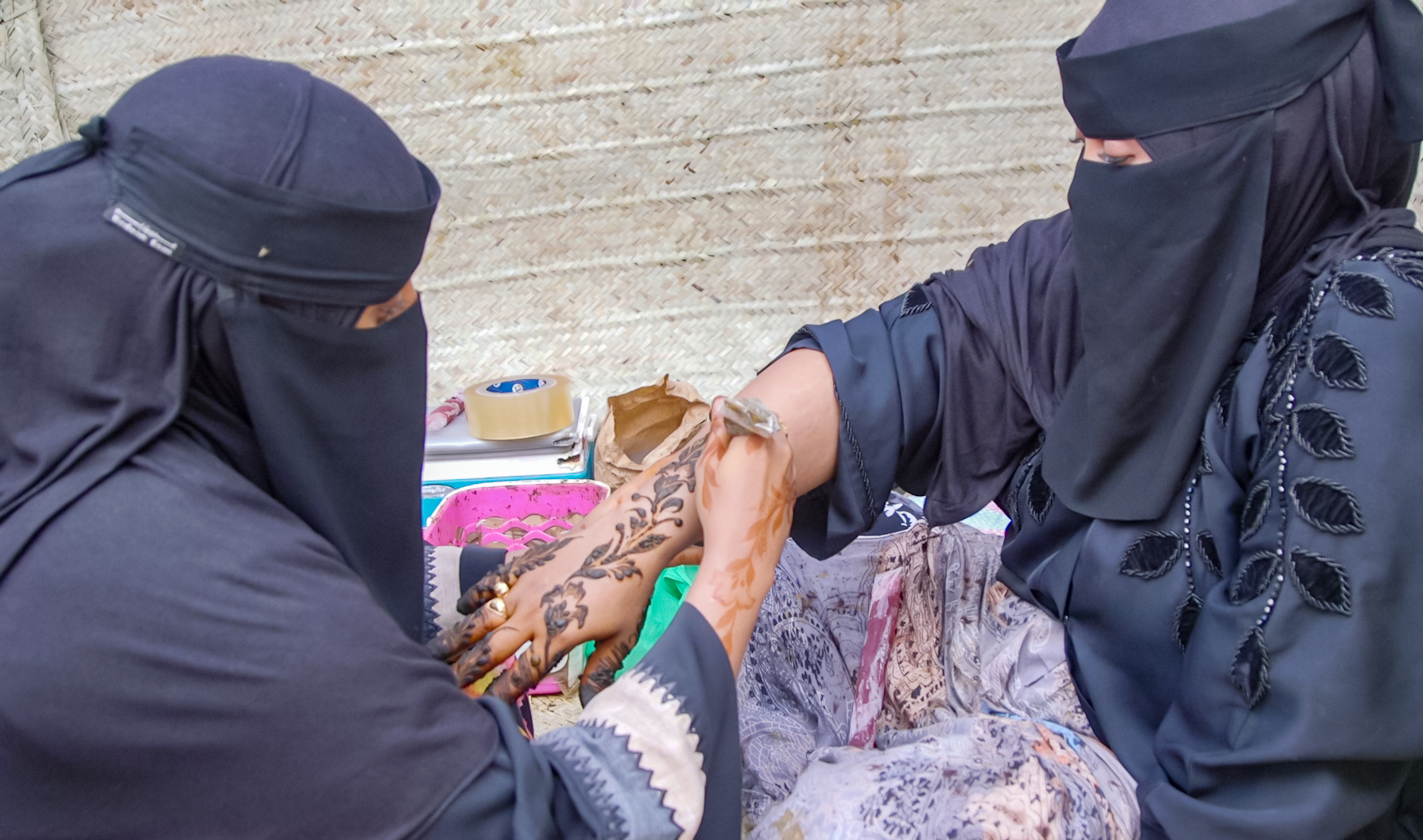By Velma Pamela and Irene Mumbi
A crowd has assembled on both sides of a narrow street in the Swahili Town of Lamu, making it difficult to see what has drawn so many people onto the road. From the sound of the festivities and the cries of approval from the crowd, it is something worth seeing. Today’s crowd is a mixture of tourists and local townspeople, with people in Western attire mingling with those dressed in more traditional garb. They are all here to witness the Lamu Cultural Festival.
In the crowd, a woman and two children mingle. The mother’s hat, worn over hijab, gives her and her infant shade while allowing them to blend into the crowd.
The quality of the henna patterns on her hands gives away her profession. Fatma Hina, 29 and mother of two is a professional henna artist scouting for her next client.
Hina was born and raised on Pate, the largest island in the Lamu archipelago and moved to Lamu Island after marrying her husband, a resident of Lamu. An artist from a young age, as she became acclimatised she fell in love with one of the island’s best-known crafts – that of the henna tattoo, or “mehndi”.
“When I was four years old, I used to draw in books. I wasn’t perfect but others would recognise that I was doing a wonderful job even without me realising it. When I got to 19, I realized I could make money from my art. I didn’t hesitate because I already had a clientele. It felt great to earn my first coins doing something I enjoyed,” she said.
The henna plant, known by its Latin name Lawsonia inermis, is believed to have originated in the Middle East and North Africa (where it is known as the Egyptian privet) and then spread across Asia via trade routes, thousands of years ago. Today, henna is cultivated around the world, from South America to Japan. It can also be found growing in the wild in Pakistan and India.
Depending on the culture, other ingredients, such as lemon juice, tea or essential oils, are sometimes added to enhance the colour or increase the longevity of the stain. The stain is released slowly when the leaves and stems of the tree are crushed and it binds with keratin—a protein that helps form hair, nails and the skin’s outer layer—to create a stain on the skin, hair and nails. The colouring tends to be darkest on hands and feet, where keratin is most concentrated.
Several applications ensure that the henna does not fade too quickly, and intricate designs are often accentuated with a synthetic black dye.
“On Lamu Island, henna is created by combining water, unripe lemon juice, and powdered henna leaf. The process takes up to 2 hours to finish, and the designs are created using a fine twig or modern-day cone-shaped tool,” Hina explained.
For more than ten years, Hina has used this preparation to create elaborate and basic patterns on her client’s skin. It is a job she has watched evolve with emerging generations demanding bolder, more exciting designs, unlike their predecessors.

That’s been good for Hina, who has seen demand for her work increase as she allowed the free-form of her early artwork to take over from the more traditional patterning regularly used by henna practitioners.
“The younger generation wants more detailed designs, it pushes me to perfect the art,” Hina said.
While Hina’s usual days are quite hectic, as she juggles her henna work with a regular business providing mobile phone services to tourists, the annual festival takes her level of activity to another level. Unlike other henna artists, she has no physical location, so she has to walk and source new clients—not easy with a child and a small baby.
“I first have to make sure my two children are fed. On good days, I get someone to hold my babies, and work flows smoothly. On days when I have no one, I have to look after them and work as I breastfeed my 4-month-old daughter,” she shared.
Another challenge is that clients are also not guaranteed every day for Hina. This pushed her to study her environment and the ebb and flow of tourists on the island.
“I earn so much more during festivals like the Lamu festival. First, on these occasions, prices are doubled. The fact that there are more clients is an additional benefit. On a good day, I have more than ten clients because both domestic and foreign tourists enjoy having henna drawn on them,” Hina said.
Henna is popular on Lamu not only at festivals but also at weddings and is even applied day-to-day by local women.
Aisha Abdalla Miraj, the County Executive Committee Member (C.E.C.M.) for Tourism, Culture, Trade and Investment in Lamu County, Kenya, has seen demand for Lamu’s henna “tattoos” explode.
“Lamu is known for the best henna artists. We normally have people coming from Oman and Dubai to seek henna artists. Henna has evolved greatly. Before the cone, our women used a stick. They would draw very beautiful patterns,” Miraj disclosed.
She explained that a growing number of women are improving their lives on the island through henna art, which is now one of Lamu’s top economic activities for women.
25-year-old Fatma Famua is one of the craft’s beneficiaries. As a teacher at a secondary school in Lamu Island, she supplements her income by offering henna painting during school holidays and days off.
“With the state of the economy, you cannot rely on a monthly income. You have to supplement your salary with something else. That is why I decided to focus on henna. With two or three clients a day, I am able to cater for my day-to-day life and I can survive with that,” Famua shared
The craft has also become a way to culturally cement Lamu’s place as one of the most important original Swahili towns—so much so that it is now a protected UNESCO site.
“Lamu is very rich in culture and we want to preserve it. These are parts of our culture that we want to preserve so that our future generation can have an archive,” Miraj added.
Seated in a stone-cobbled street with her children, Hina adds last-minute elements to a henna tattoo. Between her henna work, childcare and her mobile business, it’s been a long day. However, she ends it by buying her eldest child some snacks, a gift for helping with his sister and simply making it through the day.
“I would not say working with my children closes doors for me. I believe that God has a plan and I thank God that I have the energy to move around with my children and still make money,” Hina concluded.
bird story agency
Velma Pamela and Irene Mumbi's article centers on the bustling Lamu Cultural Festival in the Swahili town of Lamu, attracting both locals and tourists. Fatma Hina, a henna artist from Pate Island, is highlighted as she mingles through the crowd with her children, looking for new clients. Hina, who took up henna art professionally at 19, prepares henna using traditional methods and sees increased demand during festivals, balancing her craft with parenthood and a mobile phone service business.
Henna's cultural significance and economic impact on Lamu are also discussed. The C.E.C.M. for Tourism in Lamu, Aisha Abdalla Miraj, notes that Lamu is renowned for its henna artists, with significant demand even from places like Oman and Dubai. The craft has empowered local women economically, with individuals like Fatma Famua supplementing their income through henna art. The practice has also contributed to preserving Lamu's rich cultural heritage, ensuring its continuity and recognition as a UNESCO site. The story showcases the resilience and adaptability of Lamu's henna artists, who blend tradition with modern demands while balancing multiple roles.






